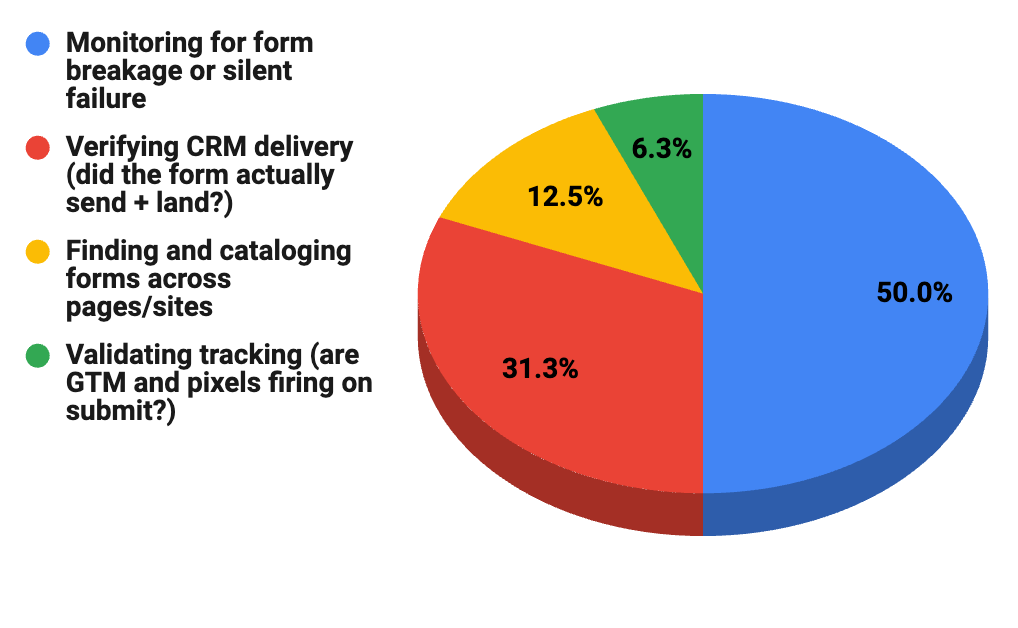Form Tech: The “Unsexy” Plumbing That Makes Your Website Work
In modern stacks like WordPress or Sanity, form technology plays a quiet but vital role. It captures leads, triggers workflows, and feeds CRMs yet it’s often fragile or ignored. This post breaks down how to stabilize it.

Why this matters:
Every campaign, landing page, ad, and site flow eventually leads to one thing: a form. Be it an inquiry form, quote form, subscribe form, or application form.
- If the form doesn’t load, they bounce.
- If it doesn’t validate, they quit.
- If it doesn’t track, you’re blind.
- If it doesn’t send data, nothing happens.
So… What was the point of all that ad spend, SEO, AI search, and dev work?
Your forms might be the most fragile and overlooked part of your entire digital experience.
And in an agentic, AI-driven future, they need to be bulletproof.
What We Mean by “Form Tech” (in this context):
One might think of "form tech" the way we think of MarTech - not just as a single tool, but as a broader ecosystem. One that includes all the components, connections, and handoffs that make a form, work - and move its data into and through the rest of your MarTech/tech stack.
In a modern website stack "form tech" spans a broader ecosystem:
- Content Management Systems (CMS) — Where forms are embedded and managed.
- Examples: WordPress, Sanity, Contentful
- Form Services — Tools for building and running forms.
- Examples: Cognito Forms, Gravity Forms, Typeform, WP Forms
- Industry-Specific Form Platforms — Purpose-built for vertical or functional needs.
- Examples: Education: Slate; Publishing & Subscription: Recurly; Events: Cvent.
- Customer Relationship Management (CRM) Systems — Where form data lands and gets acted on.
- Examples: Salesforce, HubSpot, custom CRMs
- Integration Logic & Workflow Automation — Connects forms to the rest of your stack; moves and transforms data
- Examples: Zapier, Segment, custom middleware, direct APIs. Note: Tools like Zapier or Segment offer user-friendly integration layers, but under the hood (or in custom setups) APIs are what move data between systems reliably/at scale.
- Validation, Logic & Spam Protection — Ensures clean inputs and user flow.
- Examples: Cloudflare Turnstile, client-side validation, conditional logic.
- Analytics & Conversion Tracking — Measures form effectiveness and user behavior.
- Examples: Google Tag Manager, Meta Pixel, custom events.
When any of these break - even silently - leads disappear.

Common issues we’ve seen/fixed:
- Forms that submit successfully (200 OK) but fail backend validation, with no error shown
- Conflicting embed codes that cause one form to overwrite another (e.g., MailerLite ID conflicts)
- Analytics tags that don’t fire after a form change because tracking wasn’t updated
- CAPTCHA errors that block submissions on in-app mobile browsers (e.g. Instagram)
- Forms that only work if edited by specific WordPress user roles
Crawl before you walk, and walk before you run:
We often see companies jump straight to optimization: "Let’s reduce friction," "Let’s test multistep flows," "Let’s increase conversions." But if your forms and form tech aren’t technically sound, none of that lands.
That’s why we frequently encourage a crawl / walk / run approach - forcing prioritization around velocity and impact (aka: efficiency and effectiveness).
Crawl: Fix & Stabilize
The goal here is basic reliability - across browsers and devices.
- Catalog forms - by location, purpose, usage, and priority
- Identify and fix silent failures (form doesn’t load, validate, or submit)
- Ensure success/error states are clear and consistent
- Test forms in real-world environments (not just staging/emulators)
- Test that form data/submissions land where they’re supposed to - CRM, CMS, marketing tools, etc.
- Test that form submissions trigger the expected notifications - emails, alerts, events - whatever’s expected by the user/your team.
Walk: Connect & Standardize
Focus on making form activity visible and manageable.
- Establish and use consistent field structures and naming conventions
- Establish (or improve) the integrations with other systems (CRM, marketing tools) - potentially via API or webhook
- When feasible, replace iFrames with native components to support consistent styling and reliable analytics/tag execution
- Introduce basic templating for reuse and maintenance
Run: Continuously Improve
Iterating on the experience and the metrics that prove what's working/what's not.
- Connect forms to GTM, Meta Pixel, and analytics platforms for tracking
- Add real-time inline validation
- Shorten forms and use conditional logic
- Use multistep flows where helpful
- Personalize forms based on location or metadata
- Launch tailored CRM or marketing flows based on who submitted, what they submitted, and where they came from
Next Up in Our (Unsexy but Sexy!) Series on Form Technology & Infrastructure
The way you build a quote form shouldn’t be the same as how you build an application form. Different use cases and industries demand different approaches - each with nuances in tech stack, logic, UX, and integrations.
That’s what we’ll dig into next: "Not All Forms Are Created Equal."
Also coming up in our ongoing dive into the unsexy (but sexy-to-us) world of form technology and infrastracture:
- Identifying Silent Form Failures
- From Broken to Bulletproof; Building Forms That Work
- Where AI Helps (and Doesn’t) With Forms
When it comes to form tech, what would you like us to dig into further? We'd love to hear your thoughts, here: https://form.typeform.com/to/RajUqhI7


